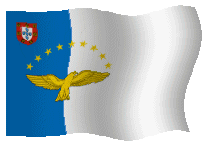
Azores
The Azores islands are not just a destination but a magical journey. At the core of our nine islands you will find a harmonious convergence of majestic scenery with the human warmth and way of life that is both timeless and contemporary. Over the years the Azores Islands have gained the trust of visitors longing for a holiday that is both safe and exciting yet peaceful. Start your journey with Azores.com, the top destination site for information travel reservations and real estate on the Internet. You'll love our service.
Flag of the Azores
The flag of the Azores is similar to the flag of Portugal used from 1830-1910, except that the Portuguese coat of arms has been removed and been replaced by the Goshawk (in Portuguese: Açor), the symbol of the Azores.
Colours
Blue and white have always been the traditional colours of the Portuguese Nation, first present in the coat of arms of Henry, Count of Portugal. During the height of the Portuguese Civil War, in the early 19th century, the Azores served as an important Liberal stronghold, with the prominent Duke of Terceira struggling against the absolutists led by Dom Miguel. The colours of the flag were thusly adopted from the Portuguese liberal flag, as to demonstrate the Azores' important role in the establishment of a constitutional monarchy in Portugal.
It should be relevant to remark that the current flag of the Azores was mostly based on the flag first employed by the Azores Liberation Front, a right-wing independentist movement which appeared after the Carnation Revolution, out of the fear of Portugal becoming a Soviet puppet-state. According to the organisation, blue and white stood for Portuguese classical liberalism, as opposed to the "totalitarian socialist forces" that would dominate the country in the mid-70's.
It should be relevant to remark that the current flag of the Azores was mostly based on the flag first employed by the Azores Liberation Front, a right-wing independentist movement which appeared after the Carnation Revolution, out of the fear of Portugal becoming a Soviet puppet-state. According to the organisation, blue and white stood for Portuguese classical liberalism, as opposed to the "totalitarian socialist forces" that would dominate the country in the mid-70's.
Symbolism
The name of the archipelago comes from the Portuguese word açor, meaning goshawk, because it was supposed to be a common bird at the time of the discovery. However these birds never existed on the islands, they actually were a local subspecies of the buzzard (Buteo buteo), that was erroneously identified as goshawks by the first explorers. The eagle on the flag is intended to be the celebration of that historical mistake. The nine stars stand for the nine islands of the archipelago, while the Portuguese lesser arms are present in the top left corner of the flag.
Disembark in S. Miguel and begin your visit in the largest city of the Azores, Ponta Delgada, where there is excellent accommodation able to ensure your stay includes every comfort and quality.Ponta Delgada, first settled by fishermen attracted by its safe port, soon began to take over as the island’s main port. It is now a dynamic and cosmopolitan city with a highly active outwardly looking cultural scene. The long road running round the port defines the city’s profile. Walk this coast road and experience its changing nature. Throughout the day, there is a constant stream of those going about their daily activities that, as the evening draws on, gives way, and especially in the summer months, to those of more recreational intent. This amply represents Ponta Delgada’s dynamism and adaptation to modern times while its accesses display the historical marks left by five centuries of history, precious testament to times gone by.
Subscrever:
Mensagens (Atom)





